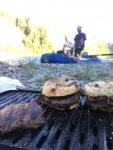I think most of us make a mistake over and over again. We go on a hunt, but don’t make the effort to think critically about 1 thing we learned and will do different next time.
Think about it, how often do magazines write about a hunt, but fail to single out an action item to change in the future? Just 1 thing, maybe something you learned about elk behavior, your rifle setup, clothing, camping system. We can consume all the information we want, but if we don’t change anything, did it really do us any good?
I’d like to start the series of discussions to get us in the habit of reviewing our hunt, and share highlights about the 1 thing we learned on a particular topic. To start, 1 thing I learned is about cooking wild game. While I was in college, we ate wild game nearly every meal to save money. My freshman year the four of us ate one bull elk, one cow elk, and three deer. The only tragedy about this was that we suffered through hundreds of meals that were just OK, but not outstanding.
Like way too many hunters, we overcooked the heck out of how our meat. Maybe it was just a bunch of guys learning to cook for the first time, or leftover traumatic memories of well-done steaks from our childhood, but we didn’t even realize what we were missing out on. I firmly believe we need to cook wild game at least 1/4 less than you would do for the equivalent piece of beef. We don’t need to start an argument about how done is the best way to prepare meat, just that we need to stop cooking it the same as you would domestic meat. Between the lower fat content and tougher nature, you will get much better flavor and moisture by taking it off the grill sooner and letting it rest before cutting.
The one thing I’ve learned about cooking any wild game with hooves is that we need to adjust our perception of the time it takes to cook it when compared to store bought meat. So what is the 1 thing you have learned about cooking wild game? Maybe it is preparation techniques, interesting recipes, or even cooking equipment suggestions so that we can make the most out of our success in the field!

Think about it, how often do magazines write about a hunt, but fail to single out an action item to change in the future? Just 1 thing, maybe something you learned about elk behavior, your rifle setup, clothing, camping system. We can consume all the information we want, but if we don’t change anything, did it really do us any good?
I’d like to start the series of discussions to get us in the habit of reviewing our hunt, and share highlights about the 1 thing we learned on a particular topic. To start, 1 thing I learned is about cooking wild game. While I was in college, we ate wild game nearly every meal to save money. My freshman year the four of us ate one bull elk, one cow elk, and three deer. The only tragedy about this was that we suffered through hundreds of meals that were just OK, but not outstanding.
Like way too many hunters, we overcooked the heck out of how our meat. Maybe it was just a bunch of guys learning to cook for the first time, or leftover traumatic memories of well-done steaks from our childhood, but we didn’t even realize what we were missing out on. I firmly believe we need to cook wild game at least 1/4 less than you would do for the equivalent piece of beef. We don’t need to start an argument about how done is the best way to prepare meat, just that we need to stop cooking it the same as you would domestic meat. Between the lower fat content and tougher nature, you will get much better flavor and moisture by taking it off the grill sooner and letting it rest before cutting.
The one thing I’ve learned about cooking any wild game with hooves is that we need to adjust our perception of the time it takes to cook it when compared to store bought meat. So what is the 1 thing you have learned about cooking wild game? Maybe it is preparation techniques, interesting recipes, or even cooking equipment suggestions so that we can make the most out of our success in the field!




